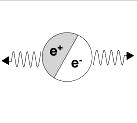
|
Home |
|
History |
|
Techniques |
|
Applications |
|
community |
|
Projects |
|
Publications |
|
Conferences |
|
Software |
|
Contact Us |
|
Software |

|
Lifetime |
|
Doppler |
|
Simulations |

|
1. Lifspecfit |
Small program for the decomposition of life-time spectra. |
|
The LT program [J.Kansy, Nucl.Instr&Meth A374 (1996) 235] has been designed in the DELPHI programming language. The program uses the WINDOWS framework, so it possesses standard appearance and provides familiar operating system. � Unconstrained number of channels in a spectrum � Possibility to fit FWHM by several Gaussians � Analysis with the help of different Trapping Models � Descrete or continuous lifetime components For more details see the LT description file (rtf format). |
|
|
3. MELT |
MELT and CONTIN - are programs for the analysis of positron lifetime spectra. In particular, the programs are useful when not discrete lifetimes are expected, but a continuous distribution of lifetimes. This is typical for positron lifetime spectroscopy in polymers and porous materials |
|
5. PALSfit �Type: Report |
A computer program for analysing positron lifetime spectra. - Roskilde : Forskningscenter Ris�, 2009 (p. 44) More information on the web site : |
|
6. PAScual
|
PAScual is a data analysis suite for Positron Annihilation Lifetime Spectroscopy (PALS). |
|
1. Vepfit |
Analysis of defects depth profiling using energy-variable continuous beam of slow positrons. |
|
2. SP |
With this program, S- and W-parameters can be calculated. The 511 keV position is determined with the help of a Gaussian fit to experimental data after background reduction. |
|
3. MePASTo |
The program MePASto was developed to facilitate the data reduction and data analysis of Coincidence Doppler Broadening (CDB) spectra. The spectrum is a function of two energies (sampled by detector 0 and detector 1) and can be displayed as a two-dimensional plot. Main problem in data reduction is to find the axis, which represents the coincident events, and to make the data along this axis available for further analysis. |
|
4. PosScope 1.2 |
The PosScope is a software tool designed for graphical representation and analysis of positron lifetime and Doppler broadening spectra. The analysis of Doppler spectra includes iterative procedure of background subtraction and numerical integration for the determination of S and W form parameters. |
|
5. SWAN |
� Analysis of the positron annihilation spectra (Doppler Broadening Technique) is often performed in terms of so-called S and W parameters. By definition the S- parameter is proportional to the contribution of the central part of the gamma spectrum and is ascribed to annihilation events with low momentum electrons (valence or conduction electrons). The W- parameter is related to the "wings" of the peak and is ascribed to annihilations with high momentum core electrons, which provide a considerable Doppler shift. By mapping the experimental points in the S-W plane with the positron energy as the running parameter, the cluster points characteristic for the layers or defects can be derived. The program SWAN (S-W ANalysis) is developed to trace these cluster points and to calculate the fractions of the positrons annihilated at the layers or defects ascribed to the cluster points. � Swan report manual.pdf - user manual; � Swan report model.pdf - description of the model; � number of examples of the SW-spectra in *.csv files. |
|
1. lt_sim |
Simulation of positron lifetime spectra. |
|
2. PosBunch |
PosBunch (Positron Bunch) is a Monte Carlo simulation code for designing a pulsed positron beam. The programme was developed in framework of the EPOS (ELBE POsitron Source) Project (see /EPOS/). Therefore the EPOS beam line underlines the programming concept of PosBunch, i.e. the construction elements foreseen in EPOS were programmed as PosBunch tools. These are two harmonic bunchers, two choppers and three accelerators. |
|
3. MIKA Doppler Download: Size: 11.7 MB |
A program to model positron states and annihilation in solids ( in linux platform ). |